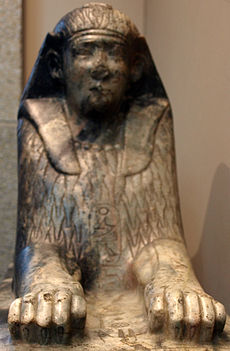Amenemhet IV.
| Name of Amenemhet IV. | |||||||||||||||||
|---|---|---|---|---|---|---|---|---|---|---|---|---|---|---|---|---|---|
 Sphinx of Amenemhet IV .; British Museum , London
|
|||||||||||||||||
| Horus name |
Ḫpr-ḫprw With designed appearances |
||||||||||||||||
| Sideline |
[S] -ḥ3b-t3wj Who makes the two countries festive |
||||||||||||||||
| Gold name |
Sḫm-bik-nbw-nṯrw Goldfalke (with) the strength of the gods |
||||||||||||||||
| Throne name |
M3ˁ-ḫrw-Rˁ Justified , a Re |
||||||||||||||||
| Proper name |
Jmn m ḥ3.t Amun is at the head |
||||||||||||||||
| Royal Papyrus Turin (No. VI./1.) |
Maa-cheru-Re M3ˁ-ḫrw-Rˁ Justified of the Re |
||||||||||||||||
| Greek Manetho variants: |
Africanus : Ammenemes Eusebius : missing Eusebius, AV : missing |
||||||||||||||||
Amenemhet IV (also Amenemhat ) was an ancient Egyptian king ( Pharaoh ) of the 12th Dynasty ( Middle Kingdom ), who ruled for about nine years (1819/1802 to 1810/1793 BC).
Origin and family
Amenemhet IV. Was the son and successor of Amenemhet III. His mother's name was Hetepti . Queen Nofrusobek was believed to be his sister wife.
Domination
He was probably co-regent of his father Amenemhet III for a short time. In the Turin Royal Papyrus the duration of his reign is given as nine years, three months and 27 days. The highest inscribed date with the ninth year of the reign was found on Sinai . A tenth year of reign after the Illahun papyrus is not assured. During his reign, Amenemhet IV undertook four expeditions to Sinai, as evidenced by construction work and inscriptions in Serabit el-Hadim . Another one can be found in the Wadi el-Hudi.
From the government years five to seven, three Nilstands brands from Kumma have survived. His successor is Nofrusobek, although a co-regency with her husband is not documented.
Construction activities
In his ten-year reign, Amenemhet IV. Some of the buildings of his father Amenemhet III. completed, including the temple of Medinet Madi . A pyramid could not be clearly assigned to him. However, some Egyptologists believe that the southern of the two pyramids of Masghuna was intended for him, as it is similar in its basic features to his father's pyramid in Hawara . In addition, he left the transverse space and portico of Amenemhet III. to decorate the temple for the deities Renenutet and Sobek in Medinet Madi.
See also
literature
- Darrell D. Baker: The Encyclopedia of the Egyptian Pharaohs, Volume I: Predynastic to the Twentieth Dynasty (3300-1069 BC). Bannerstone Press, Oakville 2008, ISBN 978-0977409440 , pp. 30-32.
- Labib Habachi : New Light on Objects of Unknown Provenance (I): A Strange Monument of Amenemhet IV and a Similar Uninscribed One (= Göttinger Miszellen . (GM) Bd. 26). Göttingen 1977, pp. 27-36.
- Thomas Schneider : Lexicon of the Pharaohs. Deutscher Taschenbuch, Munich 1996, ISBN 3-423-03365-7 , pp. 352–353.
- Thomas Schneider: The Relative Chronology of the Middle Kingdom and the Hyksos Period (Dyns. 12-17). In: Erik Hornung, Rolf Krauss, David A. Warburton (eds.): Ancient Egyptian Chronology (= Handbook of Oriental studies. Section One. The Near and Middle East. Volume 83). Brill, Leiden / Boston 2006, ISBN 978-90-04-11385-5 , pp. 168-196 ( online ).
Web links
Individual evidence
- ^ Alan H. Gardiner : The Royal Canon of Turin. Griffith Institute, Oxford 1997, ISBN 0-900416-48-3 , illustration 3.
- ^ T. Schneider: Lexicon of the Pharaohs. Munich 1996, p. 56.
| predecessor | Office | successor |
|---|---|---|
| Amenemhet III. |
King of Egypt 12th Dynasty |
Nofrusobek |
| personal data | |
|---|---|
| SURNAME | Amenemhet IV. |
| ALTERNATIVE NAMES | Amenemhet (proper name); Maa-cheru-Re (throne name); Cheper-cheperu (Horus name); Sechem-netjeru (gold name); Ammenemes |
| BRIEF DESCRIPTION | ancient Egyptian king of the 12th dynasty |
| DATE OF BIRTH | before 1819 BC Chr. |
| DATE OF DEATH | after 1809 BC Chr. |
